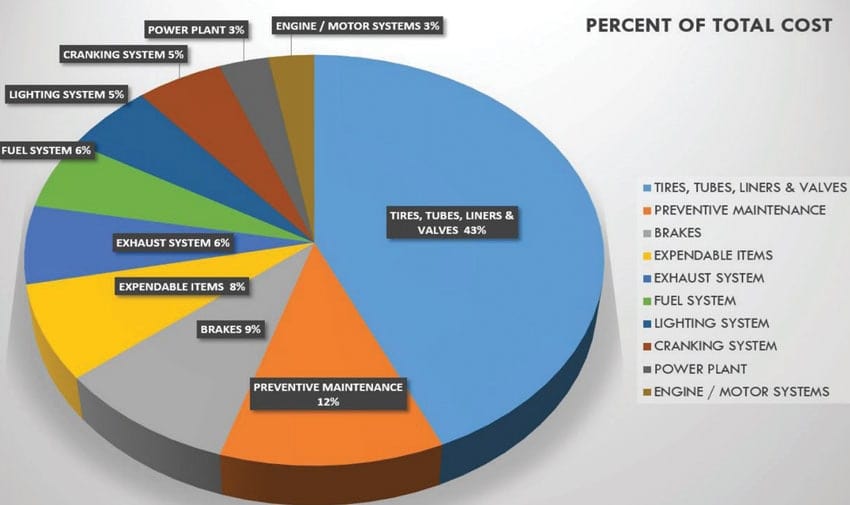DOT roadside inspections are unavoidable, but with progressive thinking and proactive measures taken by both the driver and maintenance crew, trucks will be taken out of service with less frequency over time.
By Brett Wilkie
During the 2018 Commercial Vehicle Safety Alliance’s International Roadcheck (CVSA), it was reported that more than one of every five trucks1 receiving comprehensive Level I inspections were removed from service. While this number may seem high (21.6 percent), it was actually an improvement from the previous year, where 23 percent of trucks were taken out of service due to issues with brake systems, tires and wheels.
Of those mentioned, the CVSA reported that the top truck out-of-service conditions by category were brake systems (4,536), tires and wheels (3,058) and brake adjustment (2,612). Roadside inspection officers look to identify items on a truck with specific safety violations that require the truck to be removed from service. Identified mechanical defects and violations must be repaired or replaced before the truck is permitted to proceed without a tow.
It goes without saying that a truck out of service can erode a transportation fleet’s profits—from the cost of the repairs themselves to the cost of service delays. Therefore, fleet managers in every industry must find a way to safely keep their trucks on the road. There are steps and measures that drivers and their maintenance teams can employ to reduce the chance of encountering an inspection violation during a roadside check.
Proper Documentation that is Organized
Aside from the routine maintenance itself, management should work with each driver to ensure they have the appropriate documentation in an easy-to-access binder inside the truck. Also sometimes called the Permit Book, the binder typically contains the registration cab card, insurance card, blank accident report, IFTA (International Fuel Tax Agreement) license, any additional state required license documents, emergency vendor contacts and company contacts. The binder could also include items such as Bridge Laws and ATRI Idle Compendium.
The Department of Transportation (DOT) inspector will regularly review this binder and having all documents in the proper order can not only make for a smoother inspection but can sometimes offer extra assurance to the driver that their truck’s inspection comes with less scrutiny.
Preventative Maintenance Inspections in the Yard
Every time the truck comes into the maintenance yard and is fueled up for the next trip, the person in charge of fuel should do a quick once-over to check for any problems with lights, tires and brakes. It may take extra time, but this is a minimal investment to be made when each vehicle has properly operating lights, tires and brakes. Keep in mind that per the CVSA’s data mentioned above, tires and brakes, in particular, were two of the more common items inspectors found to be in violation. In addition to reducing issues during the inspection, it will also help keep down the cost of repairs and truck downtime.

Image courtesy of Fleet Advantage.
Incentivize Drivers for Proper Pre-Trip Maintenance
Drivers also bear plenty of responsibility in keeping a truck on the road and out of trouble during DOT inspections. Fleets should incentivize drivers to ensure they are taking proper measures before and after each trip to inspect their trucks for any issues. Creating incentives such as gift cards or other monetary bonuses for performing the proper pre- and post-trip inspection can help get drivers on board with ensuring successful inspections. This can be monitored by random inspections at the gate for working lights, tires within acceptable PSI and depth thresholds, and brakes within company limits.
How Maintenance and Repair Costs Add Up
Aside from the frustrations of having a DOT inspector take your truck out of service, maintenance and repair (M&R) is critical because it significantly impacts every type of operation. Improper management of M&R can drastically erode profits from the bottom line, and the older the truck, the costlier it gets. It is also the most volatile cost.
According to a recent report on lifecycle strategy2, M&R costs on a 2015 sleeper model-year total $14,472, compared with $2,184 on a new, 2020 model-year truck, which provides a savings of $12,288. Across a fleet of 100 tractors, this amounts to $1.2 million.
These cost savings become even more significant when you look beyond the typical M&R expenses including tires, tubes, liners and valves, and include preventative maintenance measures, brakes, expendable items, exhaust systems, fuel systems and more. The older the truck, the costlier the repairs become. What is more, technician time becomes more expensive as well, because fleets end up requiring more technician time for service.
DOT roadside inspections are unavoidable, but with progressive thinking and proactive measures taken by both the driver and maintenance crew, trucks will be taken out of service with less frequency over time. Paired with new asset acquisition and lifecycle strategies that focus on a shorter truck lifecycle, M&R costs will be reduced, helping fleets realize a more profitable bottom line for their organization. | WA
Brett Wilkie is Senior Director, Fleet Services at Fleet Advantage (Fort Lauderdale, FL), a leading innovator in truck fleet business analytics, equipment financing and lifecycle cost management. As a Fleet Maintenance Professional with more than 15 years of experience in the transportation industry, Brett helps fleets and service providers maximize productivity, compliance, and efficiency. For more information please visit www.FleetAdvantage.com.
Notes
“2018 Roadcheck Out-of-Service Rate Declines from Last Year”; Transport Topics; September 12, 2018.
https://www.fleetadvantage.com/press-releases/fleet-advantage-releases-new-truck-lifecycle-data-index-comparing-2020-model-year-trucks
You may also like:
3 Steps for Training Drivers on Vehicle Inspection Requirements
